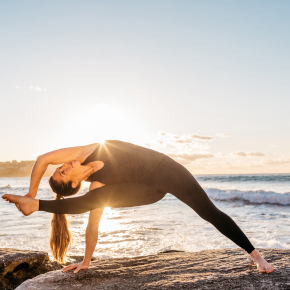How to Practice Ujjayi Breathing – 4 Common Mistakes Yogis Make
Ujjayi Pranayama is a powerful relaxation tool that can help clear your mind, relax your body, and allow you to focus.
It is a yogic breathing technique used during yoga asana practice to gently heat the body. The best part? You can do it anywhere. Anytime you need to re-center…not just on the yoga mat.
Ujjayi translates as “victorious” in Sanskrit.
Key tip: when practiced correctly, the inhale (puraka) and exhale (rechaka) creates an audible sound like waves of the ocean rolling in and out – coming from the back of your throat.
Ujjayi is a game changer for your yoga practice!
To get the maximum benefit to your mind and body – avoid these 4 common mistakes…
Ujjayi Breath benefits include:
- Gently builds heat in the body
- Increases focus and concentration
- Relaxes mind and body
- Energising & heating
- Calming effect on nervous system
Ujjayi Breathing Mistake #1 – Nostrils sucking in and flaring out
Sucking air through the nostrils like you’re smelling a bouquet of roses – this is NOT Ujjayi breathing.
If your nostrils are sucking in or flaring out – its a sign you are not breathing Ujjayi breath.
Try placing your fingers gently on the outer rims of the nostrils to feel if there is any movement when you’re breathing in through the nose.
Inhale through both nostrils evenly, making a slight constriction in the back of the throat as though you’re passing the breath through a narrow straw-like tube the pit of the throat.
Listen and feel – the nostrils should not flair out. They should be quiet, the only sound coming from deep within the back of the throat.
Mistake #2 – Only making Ujjayi sound on the Exhale
Probably the most common mistakes I hear students make with Ujjayi is only making the ocean-like sound on the EXHALATION (rather than on the inhale and exhale).
Students typically find it easier make the ocean or ‘Darth Vadar’ sound of Ujjayi on the exhale (by making a slight restriction in the throat as though you were fogging up a mirror – with your lips closed).
The challenge is to control the breath and achieve an even and consistent sound when preforming dynamic movement with sama vritti – an even inhale (puraka) and exhale (rechaka).
Practice Tip: Begin practicing in Child’s pose or comfortable seated position with your eyes closed. First establish a comfortable and steady Ujjayi breath in a static posture before attempting to maintain the Ujjayi breath in more dynamic postures.
Ujjayi Mistake #3 – Irregular Breathing, faulty On/Off switch
During the practice getting too focussed on the alignment of the body or zoning out, forgetting about the breath completely.
Often students start out strong but inconsistently switch Ujjayi off and on during the practice.
Aim to control the breath continually throughout the practice, from start to finish (until savasana).
Beginning Ujjayi at the beginning of the practice (in a static posture like child’s pose) to help calm and focus the mind, gently heat the body, and calm the nervous system.
Maintain Ujjayi throughout the practice until Savasana – when you can cease all efforts to control the breath and let the Ujjayi breath go. Otherwise, it can be difficult for you to completely switch off in Savasana and relax fully.
Ujjayi Mistake #4 – Too much effort, not enough ease
Too much intensity or excessive noise in breathing. Stay relaxed. Ujjayi should be quiet, barely audible to your neighbors.
Narrow the opening in your throat as if you were drinking through a straw and pinched the straw slightly with your finger tips. The air should slowly trickle in, not gushing through freely or gasping for air.
This type of pranayama naturally helps to slow the breath down. At first, it might feel like you’re not getting enough air quickly enough. This is an illusion of the mind.
Keep focusing on the air trickling down the throat – like sand filling up an hourglass.
Don’t worry! You have plenty of air and enough oxygen in your blood stream through the circulatory system to fuel your muscles and organs.
Relaxation is key and can open you up to deeply sublime states of mind, consciousness, and bliss!
Yoga Master B. K. S. Iyengar asserts “Breath is King”.
Mastering the breath is definitely one of the most important aspects of a complete asana practice. Becoming mindful of the breath, we can optimize unconscious breathing patterns. This in turn helps us tune into the subtle body and control our mind, body and senses.
Technique for Practicing Ujjayi Breath
- Sit in a comfortable cross-legged seated position on a block or cushion, lying down or in Childs pose.
- Close your eyes. Breathe in and out through the nose.
- Gently narrow the throat or glottis muscles in the pit of your throat (these are the muscles which help you whisper). This slight restriction (like an hour glass) narrowing in the throat creates resistance for the passage of air – slowing down the breath.
- Keep narrowing the throat as you pull air in on the inhale, and push the air out gently on the exhale.
- Listen to the audible sound like waves of the ocean rolling in and out, making the sound from the back of your throat.
- Focus on maintaining an even breath (4 -6 counts) on inhale and exhale.
- Once you can comfortably sit in a static position maintain 10-20 continuous Ujjayi breaths, the challenge is to maintain this same quality of breathing as you move through your asana practice.
Meditate on the ocean-wave like sound of the breath. Repeat for 10-20 rounds, for 5 minutes or until you feel calm and centered.
Ujjayi Advanced Tip:
Place the tip of your tongue against the roof of your mouth – just behind the upper set of teeth. This also increases focus in the mind and facilitates the Ujjayi breath.
Ujjayi as a Stand Alone Practice
Ujjayi can be practiced anywhere – anytime, to ‘victoriously’ anchor you back into the present moment.
It is especially helpful to practice to help manage anxiety, anger, and stress. You can practice this breath anytime you need to re-centre your mind and emotions.
I absolutely love teaching my students breath work – refining their technique and to help take student’s practice to the next level.
Let me know if you have any questions or how I can help!
Namaste,
x Kat Clayton
www.katclaytonyoga.com
Related Posts



